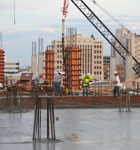At a Glance
Location
Salina, KS
Founded
1954
Employees
12–20
Specialties
Commercial planning, design, and construction for remodels and new builds
Whether tackling a 20,000-square-foot, multimillion-dollar institutional facility or a small commercial renovation for a long-standing client, Salina, Kansas-based Harbin Construction, LLC’s primary objective always is to stay within budgeting and scheduling requirements while helping its customers get the most value for their money. “We’re trying to stretch their dollar at every step,” owner Brandon Hughes says, “so that in the end our clients have the most fantastic building they could afford.”
To do that successfully for such a wide project base requires experience and expertise, both of which Harbin has earned in its nearly 60-year history. Founded by engineer Bill Harbin in 1954 with a residential focus, the company moved into commercial and industrial work as it grew. Ross Hoffhines joined Harbin in 1972, taking over ownership in 1994, and Hughes was hired in 2001 and became part owner in 2007. Locally and regionally, the firm now counts religious, medical, financial, and institutional facilities—as well as restaurants, distributors, and manufacturers—among its established clients.
When taking on a new job, Harbin first works at length to determine its clients’ priorities. For the Geary County Jail in Junction City, Kansas, a $4.5 million new-build and renovation project completed in 2009, maximizing space was the No. 1 goal. “The original multistory structure had excavated space that wasn’t being utilized,” Hughes says. “So we located that space and made use of it—adding a nearly negligible amount to the contract.”

Recognizing the importance that aesthetics play, too, the company specializes in helping clients achieve desired design effects at more affordable costs, which can be particularly key when building facilities for nonprofit organizations. After a tornado leveled most of the United Methodist Church in Chapman, Kansas, Harbin pushed funds wherever possible to build the 12,000-square-foot remodel. At home in Salina, too, the company’s value-added process afforded St. Elizabeth Ann Seton Catholic Church a degree of unexpected flexibility within its $2.2 million budget.
Harbin has a strong reputation within its community, but the company’s second-generation construction superintendents also speak to the value Harbin sees in its employees. Overall, the firm employs between 12 to 20 while subcontracting electrical and mechanical work as well as some framing and/or masonry (depending on scheduling and specific client needs). Those subcontractors are held to the same high standards of quality and professionalism, and Harbin considers them as essential as any full-time employees.
Like many in the industry, the firm is still waiting to see an upswing in the current economy, and the changed landscape of the bid market has forced the company to renavigate some of its processes. A fewer number of projects means greater competition, and Harbin now vies for area bids alongside much larger builders than before. “There used to be maybe 10–12 market players,” Hughes says. “Now companies in the $20–100 million budget range are bidding on the same projects we are.” The increase in competition, in turn, has forced lower bids, which contractors often achieve with less expensive—but unfamiliar—subcontractors.
Hughes is rarely willing to take that risk, though, favoring established relationships instead, and in some cases it costs him the job. Still, Harbin Construction has a long list of loyal customers—clients with whom its shares its forward-looking philosophy in times of slow growth. “No sense in being negative—that’s our basic approach,” Hughes says. “You create your own opportunities.” ABQ


